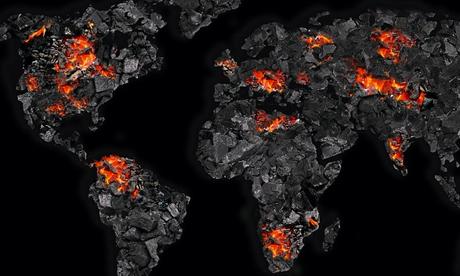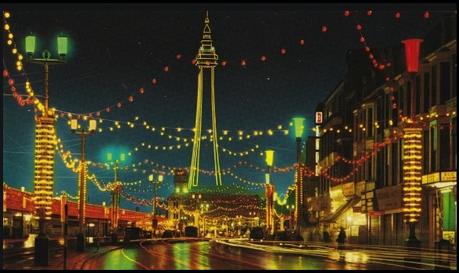Now I don't know about you, but I hardly think of coal anymore, except as a contributor to the global warming crisis. Gone are the days when domestic homes had coal bunkers or sculleries, coal scuttles or coal fires in living-rooms. Modern central heating systems rendered them pretty much redundant. However, coal is still the world's favorite fossil fuel (for better or for worse) and the beauty of writing a blog to a set theme is that every once in a while one is impelled to do a bit of digging!
Fossil literally means: found buried, dug up. Coal - a sedimentary rock formed of sunken and compressed vegetation - has been known about for thousands of years. It was used as a material to make carvings out of by the Chinese and as a source of heating by the Greeks and Romans. However, the large-scale mining and burning of coal for energy is what has powered the transformation of life on earth from agrarian to industrial societies in the last two hundred years (and the generation of electricity for the last hundred and forty); so whatever we think about coal it has to be acknowledged that without its use we wouldn't have made the phenomenal advances we have. It should also be remembered that for three-quarters of the last two centuries, the damage to the environment that rapidly escalating use of coal was inflicting went largely unrecognised or misconstrued. Coal fires, though dirty, were warming (obviously) and attractive and cosy to sit around. Our houses and factories needed light and power. Who might have imagined we were wrecking our fragile ecosphere in the process?
For the last few decades we've been vey wise to that latter fact. Coal is basically carbon and burning it releases carbon dioxide into the atmosphere. And although countries in western Europe have been scaling back on their use of the stuff, globally the mining and burning of coal is still increasing year on year. Here's a neat visual map of the world on coal-fire - and below it, some telling statistics.

Coal and where it's burning
The biggest coal reserves are located in the following countries: USA 27% (that's a quarter of the world's deposits), Russia 17%, China 14%, India 10%, Australia 9%, South Africa 5%, Ukraine 4%, Kazakhstan 4%... and the rest of the world another 10%.The biggest users of coal are: China 50% (that's half the world's consumption), India 11%, USA 9%, Russia 3%, Germany 3%, Japan 2%, Brazil 2%... and another hundred countries accounting for the remaining 20% (with the UK twenty-first on the list at 0.5%).
I find all of those to be interesting and staggering statistics which help to explain both the rise of China and India as economic super-powers and the reason why the USA, Russia, China, India and Australia are so slow to step up to the climate change agenda.
However, just imagine if we had not gone down the route of mining and burning coal for heat, steam power and electricity: "a night so black the stars looked like scattered sugar crystals", to steal a magnificent image from Ishmael Reed's satirical anti-slavery novel, Flight To Canada. There might have been no Illuminati (see below*) to brighten up the jewel of the north.
Blackpool's illuminations began in a small but spectacular way in September 1879 when just eight carbon arc lamps bathed a section of the Promenade in light - artificial sunshine as it was dubbed. Blackpool was the first place in the country to boast such a feature. This was well over a year before Thomas Edison patented the electric light bulb. People flocked from all over the north of England to marvel at the sight, for up until that point most lighting was gas-powered or candle, neither of which could match the brilliance day-for-night of Blackpool's electric lamps.
In 1912, the Royal Family made its first visit to Blackpool. Princess Louise opened a new stretch of the Promenade (named Princess Parade in her honour). Festoons of garland lamps illuminated the new section of the Promenade with 10,000 light bulbs. From that point onwards the Blackpool illuminations grew in size, splendour and renown, the only dark periods being the enforced black-out during two world wars.
Nowadays, Blackpool blazes brightly along a six-mile stretch of promenade from Starr Gate in the south to Bispham in the north, every night from August to November during the sixty-six days of the annual Illuminations season, and people come from all over the country (and the world) to tour the lights. The current illuminations feature well over one million bulbs - all powered by electricity, which for most of the 20th century was generated, of course, from burning coal.

a section of Blackpool's famous lights
One can but hope the illuminations will return in August (and every year after), in as splendid a fashion as they were BC (before Coronavirus); and even better still if their electricity can be derived from renewable non-fossil sources in future - what an innovative showcase that would make of the town...*The reference to the Illuminati above and in my latest poem is in tribute to a large brown road sign that stands at the Blackpool end of the M55 motorway. It is supposed to read Illuminations (with a lane indicator to filter the left-hand line of traffic off towards north shore) but the right-most panel was missing and so for years it just read Illuminati (a source of joy to fans of secret societies).
I've attempted this week some poetry about anthracite, the hardest and purest of coals (on a scale from peat through lignite and bitumen up to graphite). It's name I'm pleased to say derives, somewhat tautologically, from the Greek ἀνθρακίτης (anthrakites) - literally 'coal-like'. See what you think of the coal poem, though I add the usual caveat that it is a work-in-progress and may metamorphose further.
Anthracite
Anthracite, black as night, you
former forest or swamp growth
from a steamier age,
you slumped with captured carbon
and the occasional fierce beast
in your decaying branches, down
below the surface of a shifting sea,
to repose dehydrating,
compressed by an over-layering
through dusty eons and eras -
Paleozoic, Mesozoic, Cenozoic -
to be baked from sedimentary
to low-grade metamorphosis
before arising as the earth convulsed
in swapping submarine for superstrate.
Illuminati, we sought you out,
mined you, admired you
with your sub-metallic lustre,
fired your calorific potential
to drive our blockbuster expansion
as industrial nations. We failed
to realize until this late stage
the true reversal of fortunes
we were engaged in: releasing
back into our fragile ecosphere
in two short torrid centuries
all the carbon that had lain
well hid for million of years.
Anthracite, black as night, you
dark mirror to our overheating state.
Thanks for reading, S ;-) Email ThisBlogThis!Share to TwitterShare to Facebook
Reactions:
